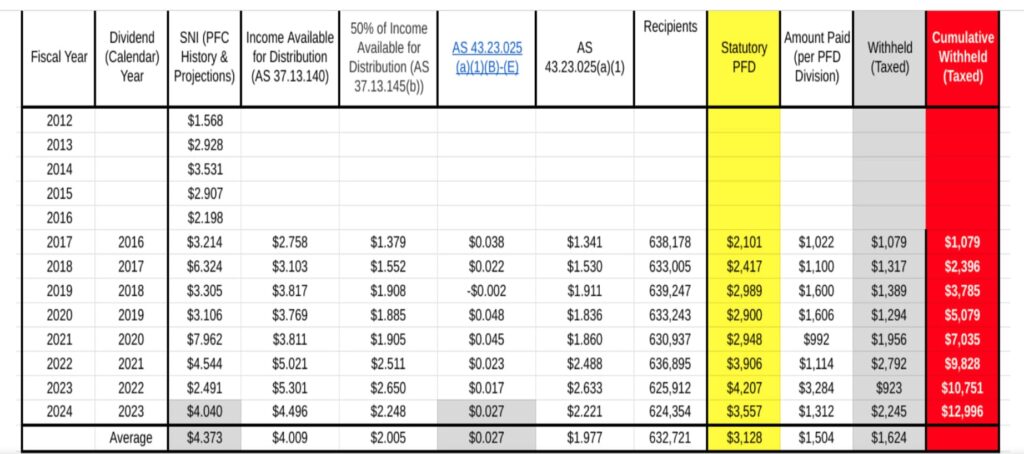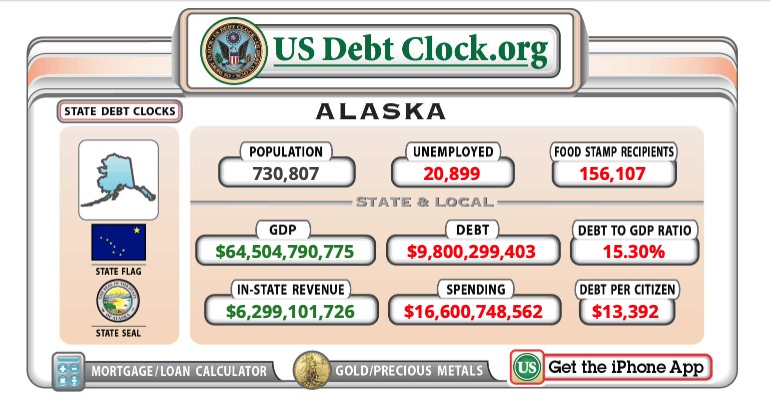By MICHAEL TAVOLIERO
According to the chart below, fully eligible Alaskans are owed $14,619 in Permanent Fund dividend remittances. For a family of four, that’s $58,476.
What’s truly fascinating is that some so-called “conservative” legislators claim the Alaska Permanent Fund Dividend — and the significant loss of revenue to Alaskans—won’t be a big issue in the upcoming election.

Yet, come session time, they’ll spend countless hours wrangling over it, just like they have every year since 2016. So, what’s the real priority? Protecting the bureaucracy, or stopping the Alaska Legislature from reaching into our pockets and snatching what is owed?
The Must Read Alaska column from Sept. 10, written by Rep. Kevin McCabe, reads as a defense of the Legislature’s inaction on the PFD, framing it in a way that echoes statist reasoning.
McCabe’s argument suggests that legislative neglect is justified by broader concerns, harking back to former Gov. Bill Walker’s misleading claims that the state was running out of money and needed to prioritize government functions over fulfilling the full PFD.
The column reflects a familiar pattern of defending cuts to the PFD in favor of protecting the state bureaucracy. And yet since 2016, the state’s operating budget has increased by over 15%.
McCabe defends legislators who vote for budgets that reduce dividends, arguing that these decisions are necessary to address broader state priorities like infrastructure and essential services. His argument highlights the complexity of the budget process and denotes that voting for less than a full PFD should not automatically label a legislator as a “PFD thief.” However, this reasoning downplays the significant financial impact reduced PFD payments have on Alaskans, particularly those in low-income and rural areas. Additionally, the claims of shifting public opinion against full PFD payments lack concrete evidence to support the assertion.
Let’s be frank, the Alaska government has created this struggle to serve its population effectively due to centralization, inefficiencies, and a focus on maintaining the bureaucracy rather than directly addressing constituent needs. This misalignment of values, priorities and ethical disingenuousness undermines the potential for effective governance in a state with unique geographic and economic challenges.
What is startling to me is this is statism — the authoritarian collectivist belief that the state should have substantial control over social and economic affairs, often prioritizing government authority and interests over individual or community benefits. In such arguments, the state’s needs (e.g., infrastructure, bureaucracy, or public programs) are framed as paramount, even when it conflicts with individual benefits, such as the PFD.
The PFD is a cornerstone of Alaska’s political and economic landscape, hailed as a unique model of wealth distribution in the United States. Established in 1980 as a means to share the state’s vast oil wealth with its residents, the PFD has undergone significant changes over the years. The debate surrounding the dividend has evolved from a symbol of Alaska pride and prosperity into a battleground over state spending, with the Alaska Legislature increasingly prioritizing the expansion of the administrative state over providing Alaskans their rightful share of the fund.
Alaska’s vast size and the dispersion of its population — split 66%/34% between urban centers like Anchorage, Fairbanks and Juneau and remote rural communities — make it challenging for a centralized government to effectively address local needs. Centralized decision-making in Juneau fails to understand or prioritize the specific needs of remote areas creating this elitist mentality.
Alaska’s large bureaucracy does not translate to effective service delivery. Alaska’s government faces significant inefficiencies in its allocation of resources, often spending vast amounts on administration rather than directly providing services. This results in high overhead costs and a bloated state apparatus that struggles to effectively manage essential programs like healthcare, education, and transportation across the entire state.
A significant portion of Alaska’s budget comes from federal sources — 56% of its revenue — rather than state-generated revenue. This keeps Alaska in colony status rather than the natural resource juggernaut it rightfully is. Federal revenue reliance on external funding mismanages or mismatches between how money is spent and the actual needs of the population. Additionally, with a bureaucracy dependent on federal grants, much of the focus goes toward securing funds rather than efficiently delivering services to Alaskans.
Instead of streamlining government operations to better serve constituents, Alaska’s government has prioritized growing the administrative state. This includes expanding government jobs, which often benefits urban centers and state workers but doesn’t translate into direct improvements in public services. This growth has been partly funded by reducing the PFD by billions of dollars, frustrating many Alaskans who feel they are being deprived of their rightful share of state oil revenues.
The Alaska Permanent Fund was born out of the Prudhoe Bay oil discovery in 1968, which promised Alaska vast wealth. But there was also a recognition that oil revenues would eventually dry up, leaving the state without a reliable financial foundation.
In 1976, under Gov. Jay Hammond, Alaskans approved an amendment to the state constitution establishing the Permanent Fund. Its purpose was to invest at least 25% of oil revenues for future generations. The fund was designed to act as a savings account, accumulating earnings that would provide a financial buffer when oil production inevitably declined.
In 1980, the Alaska Legislature established the Permanent Fund dividend program, which would pay out a portion of the fund’s earnings directly to Alaskan residents. The program was revolutionary — a government distributing wealth directly to its people rather than filtering it through bureaucratic channels. For decades, the dividend represented a tangible benefit of living in Alaska, a reflection of the state’s unique relationship with its natural resources.
Since its inception, the PFD has faced threats from the Legislature, as lawmakers grapple with imagined growing budget deficits and the spurious pressures of funding government services mostly pontificated by special interests and unions. The tension between using the fund’s earnings to support government programs and paying dividends to Alaskans has become increasingly pronounced in recent years.
In 2016, Gov. Walker made a controversial decision to cut the PFD by nearly half, marking the first time in Alaska’s history that a governor reduced the dividend in response to Chicken Little fiscal shortfalls. This set a dangerous precedent: when the state needs money, lawmakers can tap into the fund at the expense of represented residents.
The Alaska Legislature’s actions since 2016 suggest a preference for growing the state bureaucracy over paying out full dividends. Every year, legislative battles are waged over how much of the fund’s earnings should be allocated to the dividend versus state programs. Due in part to fluctuating oil prices and production, the pressure to divert PFD money into the general budget has intensified. Despite the fact that the dividend was created as a direct benefit to Alaskans, lawmakers have increasingly used the fund as a tool to prop up the state’s growing administrative apparatus rather than directly decrease the size of the bureaucracy.
The Legislature’s decisions on the PFD reflect a broader trend: the prioritization of state spending over individual benefits. The administrative state in Alaska continues to grow, with ever-increasing funding directed toward government departments, salaries, and programs at the expense of the dividend. Meanwhile, the people of Alaska—those whom the fund was originally intended to benefit—are left with a reduced share of the wealth their state generates.
This shift in priorities is particularly striking given the rhetoric of many “conservative” legislators who claim to champion smaller government and fiscal responsibility. While these representatives may speak of reducing government waste and cutting unnecessary spending, their actions regarding the PFD tell a different story.
Year after year, they have allowed the growth of the state bureaucracy while Alaskans watch their dividends shrink. The result is an administrative state that is becoming increasingly entrenched, while the citizens who own the wealth of the state are left with less.
The U.S. Debt Clock, Alaska section, reports the current population at over 730,800, Alaska’s unemployed are 20,899. Alaska’s food stamp (EBT) recipients number over 156,107.
https://www.usdebtclock.org/state-debt-clocks/state-of-alaska-debt-clock.html
This is over 21% of the state’s population. State revenue amounts to $6.3 Billion, but state spending over $16.6 Billion (remember that monetary heroin injection of 56% federal money) and a debt per citizen of over $13,392. Why do our state legislators choose to ignore the anguish?
The reduction of the PFD has had tangible impacts on Alaskan families, especially in a state with a high cost of living. For many, the dividend represents a significant portion of their annual income, helping to cover basic expenses such as heating, food, and transportation. The decision to prioritize state spending over full dividends disproportionately affects lower-income Alaskans and rural communities, where economic opportunities are fewer, and the cost of goods and services is higher.
It is time for Alaska’s representative government to establish its priorities. Should the state continue to grow its bureaucracy, or should the legislature respect the original intent of the PFD by ensuring Alaskans receive their full share of the wealth generated by the state’s natural resources?
The current trajectory suggests sadly and coldly that, for many lawmakers, the expansion of the administrative state is a more pressing concern than the financial well-being of their constituents.
In the end, the issue is not merely about dollars and cents, but about principles. The legislature must decide whether its role is to serve the people or the state itself.
Michael Tavoliero is a resident of Eagle River and writes for Must Read Alaska.


The bureaucratic tyranny that exists in local, state and federal government today is 100% focused on maintaining a stranglehold on the fiefdoms created by these unconstitutional entities. The only way they will ever be eliminated is when they collapse the economy to the point they can no longer be supported. Abolishing 501 3 C corporations would be a huge step, which will never occur. The creation of these non contributing entities was to support the election of useful idiots to perpetuate the problem, so the elected will never eliminate them.
We are close to a massive financial collapse, overshadowing the so called depression by a factor of 10.
Printing money, federal and state spending, grants and subsidies are not the basis for a functional economy.
There is no way to vote out of this mess, it has replaced the industrial and resource extraction economy decades ago.
We are generations deep into a society where the percentage of the population which is productive in meaningful economic activities is less than 35%.
The PFD will simply be looted as our industry has been and national wealth exfiltrated.
The state maintains ownership of subsurface rights, and we are all shareholders of the revenue from development of those assets. If we were denied our dividend would the state still maintain ownership over subsurface rights? Perhaps we should reform Alaska’s land law accordingly?
Not only is that $14,000+ for each eligible resident the legislators withheld for their pet projects and government growth, but it’s over $8 Billion kept out of the economy that trickles down to the benefit of all Alaskans.
No matter how good the campaign ads are for the incumbents, don’t vote for the incumbents. Every one of them won running either the first election or on a reelection always promise to defend the PFD. If they can’t keep their promise they need to be fired. I got a campaign poster from Kelly Merrick. Typical example. She runs as Republican but acts like a Democrat. She’s pro ranked choice voting. I wonder why?
Vote her out.
Yeah, it’s just a slogan. ” I will protect the PFD”……..
Oh, you haven’t seen anything yet, Michael.
.
Ben Carpenter’s campaign to infect productive Alaskans with his sales tax ought to a grow a bureaucracy the likes of which we haven’t seen before and eat up PFD’s in ways we can only dream about.
.
No? What stops them?
Who should I vote for? These are my options for State Senator District D:
Republican Jesse Bjorkman, who caucuses with the Democrats;
Republican Ben Carpenter, who pushes a state sales tax (that will never, ever, ever, go higher than 2%);
or
Registered Democrat Tina Wegener
TIA!
Might be worth giving Ben a chance to rethink his tax talk…
.
If Ben doesn’t want to do that, why not pick one of the other two, heads or tails, at least they did you the courtesy of not saying right out of the gate they’re gonna take your money and give it to somebody more deserving than you.
.
And, since you know what they are, what they’ll do, you won’t have to waste time being disappointed in them.
Our “representatives” no longer represent US. They only serve the collective interests of the unelected bureaucracy. That’s it! We no longer live in a constitutional state, we live In a fiefdom of the administrative state
Oh, but I see a proposal for a sales tax, too, because the ‘poor’ state can’t meet all of its desired payoffs (to critical voting blocks). The bloated pig will never stop the gluttonous behavior until it dies, then it’s over for all of us who do not strive for our own financial independence.
Tavoliero is absolutely right about the legislature, administration and bureaucracy–regarding the PF. They are inveterately corrupt. We must accept the reality that Hammond and others failed to understand it is impossible to create laws and structures to avoid such corruption. If the citizenry doesn’t take the problem into it’s own hands it will never be solved. Solution: liquidate the entire fund with one full, pro rata, distribution to all eligible Alaskans. $79,115,200,000/730,807 = $108,257 per Alaskan. Family of four: $433,029. Let’s get it done. They will try clawing it back; but, at least they will need to explain why you should pay more and more taxes…. as the way things should be.
If I run for governor, my principal platform issue would be to represent a mandate for a popular constitutional referendum to liquidate the fund to the people forthwith.
Please consider running for Governor.
Kamala Harris says she’s going to create an opportunity economy where all will benefit. We’ll then be told we don’t need PFDs.
There is a simple solution to the PFD theft. A constitutional amendment. Stating something along the lines of, ‘A full annual PFD is to be paid out first before anything else. If, and only if, there is any money remaining after a full annual PFD is paid out, then that money can be spent on other crap …
Your welcome!
Not only will they never stop raiding the PFD, eventually they’ll find a way to get their hands on the corpus. Addicts can’t help themselves
Grow the administrative state in local, state and federal government and that grows a voter bloc in support of itself.
And the MASSIVE expansion of SNAP benefits keeps growing government like a cancer. Thank you Senate RINOs that empowered the Left to foist this through. Walking the talk, are we now?